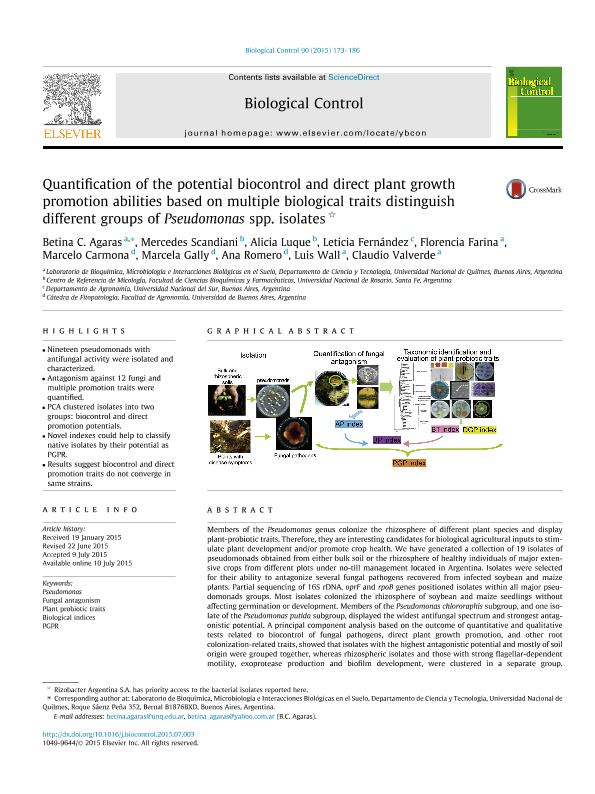Mostrar el registro sencillo del ítem
dc.contributor.author
Agaras, Betina Cecilia

dc.contributor.author
Scandiani, María Mercedes

dc.contributor.author
Luque, Alicia
dc.contributor.author
Fernandez, Leticia Andrea

dc.contributor.author
Farina, María Florencia

dc.contributor.author
Carmona, Marcelo Anibal

dc.contributor.author
Gally, Marcela Edith

dc.contributor.author
Romero, Ana María

dc.contributor.author
Wall, Luis Gabriel

dc.contributor.author
Valverde, Claudio Fabián

dc.date.available
2018-04-11T19:11:21Z
dc.date.issued
2015-07
dc.identifier.citation
Agaras, Betina Cecilia; Scandiani, María Mercedes; Luque, Alicia; Fernandez, Leticia Andrea; Farina, María Florencia; et al.; Quantification of the potential biocontrol and direct plant growth promotion abilities based on multiple biological traits distinguish different groups of Pseudomonas spp isolates; Academic Press Inc Elsevier Science; Biological Control; 90; 7-2015; 173-186
dc.identifier.issn
1049-9644
dc.identifier.uri
http://hdl.handle.net/11336/41770
dc.description.abstract
Members of the Pseudomonas genus colonize the rhizosphere of different plant species and display plant-probiotic traits. Therefore, they are interesting candidates for biological agricultural inputs to stimulate plant development and/or promote crop health. We have generated a collection of 19 isolates of pseudomonads obtained from either bulk soil or the rhizosphere of healthy individuals of major extensive crops from different plots under no-till management located in Argentina. Isolates were selected for their ability to antagonize several fungal pathogens recovered from infected soybean and maize plants. Partial sequencing of 16S rDNA, oprF and rpoB genes positioned isolates within all major pseudomonads groups. Most isolates colonized the rhizosphere of soybean and maize seedlings without affecting germination or development. Members of the P. chlororaphis subgroup, and one isolate of the P. putida subgroup, displayed the widest antifungal spectrum and strongest antagonistic potential. A principal component analysis based on the outcome of quantitative and qualitative tests related to biocontrol of fungal pathogens, direct plant growth promotion, and other root colonization-related traits, showed that isolates with the highest antagonistic potential and mostly of soil origin were grouped together, whereas rhizospheric isolates and those with strong flagellar-dependent motility, exoprotease production and biofilm development, were clustered in a separate group. Interestingly, quantitative comparison of newly developed biocontrol and direct growth promotion indices revealed that these two plant probiotic traits are rather associated to different set of isolates, and rarely present in the same pseudomonad strains. These indices could be employed to screen and categorize isolates by their potential to act as a biocontrol or a biofertilizer agent.
dc.format
application/pdf
dc.language.iso
eng
dc.publisher
Academic Press Inc Elsevier Science

dc.rights
info:eu-repo/semantics/openAccess
dc.rights.uri
https://creativecommons.org/licenses/by-nc-sa/2.5/ar/
dc.subject
Pseudomonas
dc.subject
Fungal Antagonism
dc.subject
Plant Probiotic Traits
dc.subject
Pgpr
dc.subject.classification
Agricultura

dc.subject.classification
Agricultura, Silvicultura y Pesca

dc.subject.classification
CIENCIAS AGRÍCOLAS

dc.title
Quantification of the potential biocontrol and direct plant growth promotion abilities based on multiple biological traits distinguish different groups of Pseudomonas spp isolates
dc.type
info:eu-repo/semantics/article
dc.type
info:ar-repo/semantics/artículo
dc.type
info:eu-repo/semantics/publishedVersion
dc.date.updated
2018-04-11T15:16:01Z
dc.journal.volume
90
dc.journal.pagination
173-186
dc.journal.pais
Estados Unidos

dc.journal.ciudad
San Diego
dc.description.fil
Fil: Agaras, Betina Cecilia. Consejo Nacional de Investigaciones Científicas y Técnicas; Argentina. Universidad Nacional de Quilmes. Departamento de Ciencia y Tecnología; Argentina
dc.description.fil
Fil: Scandiani, María Mercedes. Universidad Nacional de Rosario. Facultad de Ciencias Bioquímicas y Farmacéuticas; Argentina
dc.description.fil
Fil: Luque, Alicia. Universidad Nacional de Rosario. Facultad de Ciencias Bioquímicas y Farmacéuticas; Argentina
dc.description.fil
Fil: Fernandez, Leticia Andrea. Consejo Nacional de Investigaciones Científicas y Técnicas; Argentina. Universidad Nacional del Sur. Departamento de Agronomía; Argentina
dc.description.fil
Fil: Farina, María Florencia. Universidad Nacional de Quilmes. Departamento de Ciencia y Tecnología; Argentina
dc.description.fil
Fil: Carmona, Marcelo Anibal. Consejo Nacional de Investigaciones Científicas y Técnicas; Argentina. Universidad de Buenos Aires. Facultad de Agronomía. Departamento de Producción Vegetal. Cátedra de Fitopatología; Argentina
dc.description.fil
Fil: Gally, Marcela Edith. Universidad de Buenos Aires. Facultad de Agronomía. Departamento de Producción Vegetal. Cátedra de Fitopatología; Argentina
dc.description.fil
Fil: Romero, Ana María. Consejo Nacional de Investigaciones Científicas y Técnicas; Argentina. Universidad de Buenos Aires. Facultad de Agronomía. Departamento de Producción Vegetal. Cátedra de Fitopatología; Argentina
dc.description.fil
Fil: Wall, Luis Gabriel. Consejo Nacional de Investigaciones Científicas y Técnicas; Argentina. Universidad Nacional de Quilmes. Departamento de Ciencia y Tecnología; Argentina
dc.description.fil
Fil: Valverde, Claudio Fabián. Universidad Nacional de Quilmes. Departamento de Ciencia y Tecnología; Argentina
dc.journal.title
Biological Control

dc.relation.alternativeid
info:eu-repo/semantics/altIdentifier/doi/http://dx.doi.org/10.1016/j.biocontrol.2015.07.003
dc.relation.alternativeid
info:eu-repo/semantics/altIdentifier/url/https://www.sciencedirect.com/science/article/pii/S1049964415300086
Archivos asociados
